Back to School – 5 American films on high-school life
School starts on September 14 – after so many months of uncertainty – a sign that we’re slowly getting back to the old normal. In order to lighten the nostalgia surrounding the excitement of buying new backpacks and the habit of writing with chalk on blackboards, I thought of compiling a list of the best American films that explore the high school experience (leaving aside many of the popular titles that we are all embarrassed of having as guilty pleasures). Why American movies? Because, on the one hand, the long-known feuds between the popular, the rockers or the nerds are always more campy than the 1986 Romanian film The Graduates – and, on the other hand, the so-popular genre of the ’80s reveals a simple and self-sufficient school, summarised in just a few common images (the school bell that always sounds the same, the classroom where paper planes fly around, the hallway where all students open their lockers at the same time, the gym where they’re always playing basketball). The films below are not entirely devoid of the clichés of the genre, but have the quality of questioning them in various ways.
- Dead Poets Society (dir. Peter Weir, 1989)
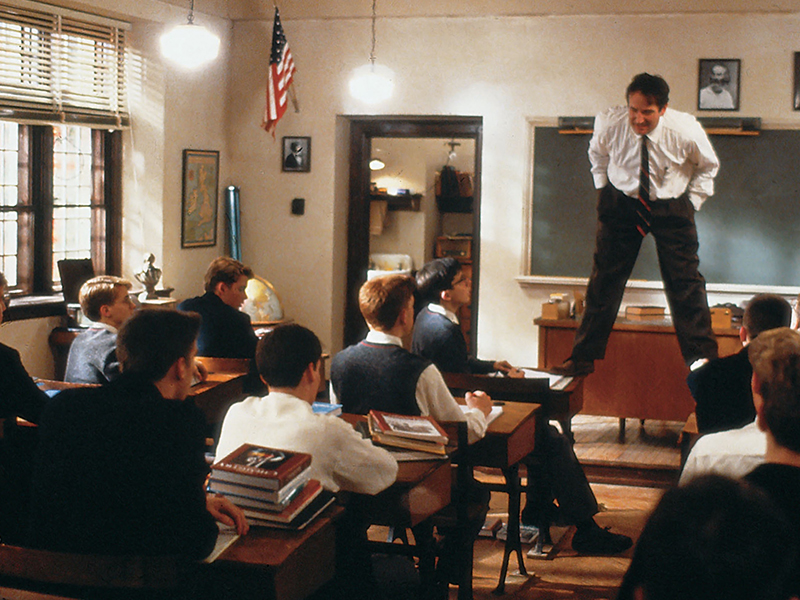
It’s 1959, in Vermont, at Welton Academy, a sort of young white male boarding school so wrapped up in traditional values, that any sign of rebellion leads to execution; the key words are, of course, order and discipline. In this landscape emerges literature professor Keating (Robin Williams), a former student of the school with very hip visions (he tears apart the pages of the titans who spoke about units of measurement in poetry, he impersonates Marlon Brando, he talks to his students about existentialism, a part of history that none of the tight professors teach about; in this oh, so demanding universe, he is a drop of life and romantic spontaneity that any young man would fall in love with). Keating temporarily diverts them from math and science (everyone will go to law or economics after school anyway), but it also takes them on a very dark path. From what the film shows us, the eternal “carpe diem” (found in almost any film with rebellious teenagers in the ’90s, now a diminutive worthy of being the center of uninspired tattoos) is all that remains in the students’ minds during literature class, meaning something flimsy, which could be interpreted in all sorts of ways by a youngster’s mind. The students don’t end up setting the academy on fire, but they make enough noise which leads to questioning the core of the teacher’s methods – the intentions may be good, but who else is there to teach poetic realism? And, moreover, who else is going to show them where to put a stop to their small rebellions? Keating seems to be a cure for all the suffering the students go through (abusive and obtuse backgrounds), but the bandages he applies on their wounds only give birth to even more heinous monsters.
- Rushmore (dir. Wes Anderson, 1998)
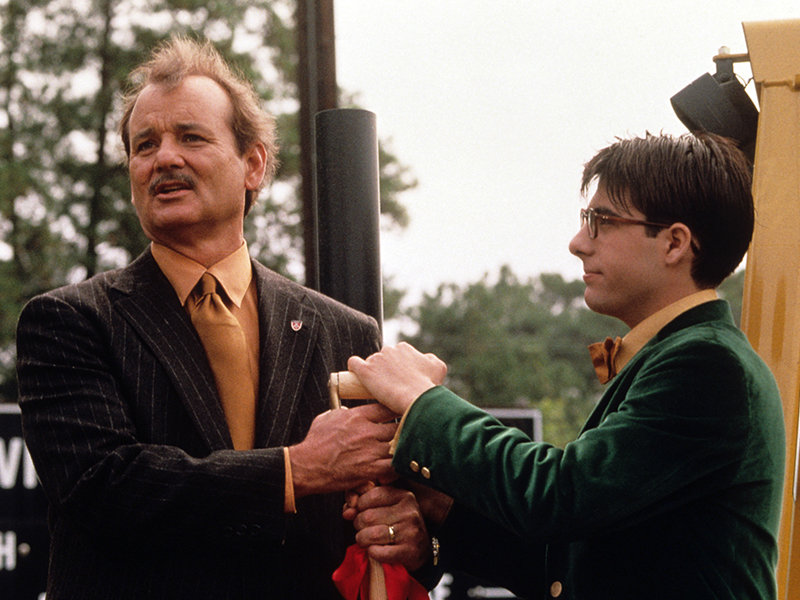
Rushmore is Wes Anderson’s second feature film – and sets the foundation for some of the director’s landmarks (a naive intertextuality, looking into the camera, the sporadic use of the tracking shot, the voice over, etc.). Among these high-school movies, this entry rather comes from a personal spot (I admit): Max Fisher (Jason Schwartzman) is not really shown in class except for the the first sequences, when he is daydreaming about coming with the solution for the most difficult math problem ever, leaving his colleagues and teacher in absolute awe of him; the rest of the time, he’s a mediocre student, but very meticulous in wearing his school uniform. The reason for that is his fetish love for Rushmore, the college where he studies (he enrolls in all possible courses and builds an igloo universe, and since he spends too much of his time under the school roof, he even forgets that his father is just a barber in the midst of the banker parents who bring their children at school). But, just like in any Wes Anderson film, there’s also an impossible quest (this time a love affair), in which he ends up competing with a man the same age of his father for the heart of a teacher; the kid’s imagination is sometimes naive (trying to turn the sports field into a colossal aquarium), sometimes amazing (he stages, with the high school team, a play about the Vietnam War, planting real explosives on the set).
- Lady Bird (dir. Greta Gerwig, 2017)
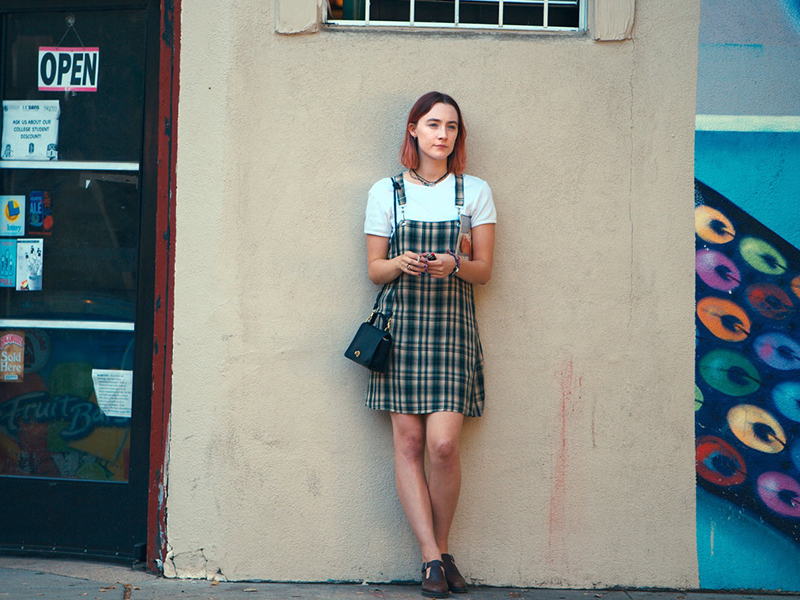
Among the most recent American films with high school students (my list features mostly films from the 90’s), Lady Bird is definitely on the highest rank – reminding of Noah Baumbach’s indie films (Gerwig being one of Baumbach’s collaborators, as a screenwriter and actress) and seemingly rooted in the Gerwig’s autobiographical experience, who was also born in Sacramento, just like the protagonist of the film. Christine aka Lady Bird (Saoirse Ronan) subscribes to the common teenager behavior, begging her father to stop the car and let her out half a mile from the high school entrance, so that her friends won’t see them together; accepting the name she was given by her parents is more outrageous to her than believing in God, even though she attends a Catholic college; last but not least, although she never actually admits it, her best friend is her mother (Laurie Metcalf), and the two of them share this bourgeois fantasy, where, during weekends, they visit the most expensive homes for sale they would never afford buying. The money idea is obsessive – because it’s the unit of measure in everything, even when choosing a college (Christine would like to go to New York, but her parents are lower-middle class); the fact that they live on the outskirts of the city seems to be a good subject for self-irony, but Christine sees it as a curse, actually. After getting exactly where she wanted, away from home and her mother’s nagging eyes, Christine finally embraces her family. Lady Bird is about our efforts to get as far away as possible from our hometown and its air, which seemed unbreathable and unfamiliar, because our world would always have been elsewhere, or so we would have thought, and the shock of realizing that we just indulged in some silly fantasies – in this big, hectic world, no one will ask you to get back home at reasonable hours and no one will be concerned with how you are or what you’re doing.
- Heathers (dir. Michael Lehmann, 1989)
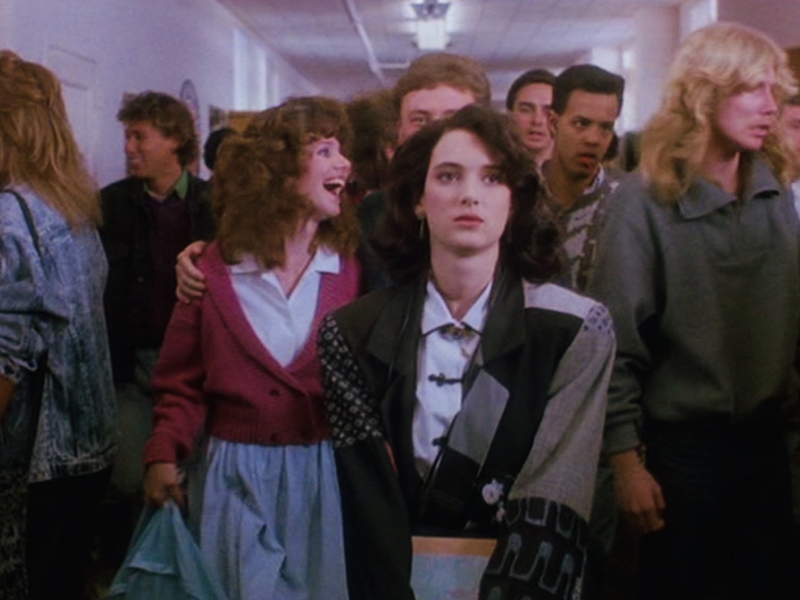
When it comes to the high school genre, Heathers is explosive (de facto): all the clichés that run in the beginning of the film (the eternal group of mean girls, popular and unapproachable, the standard groups of nerds and bad boys) are to be overturned one by one, when Veronica (Winona Ryder, on the verge of becoming truly popular) and JD (Christian Slater, the bad boy who carries a gun around school) eliminate one by one the entire competition, by killing the high school “stars”. Made to look like suicides, the murders are meant to erase the popular kid image from the face of the Earth, leaving room for a more welcoming blood. As part of staging the suicides process, Veronica writes farewell notes that are far too complex, but which have nothing to do with reality – she makes up a depression related to self-image or a homosexual relationship between two guys; simply put, their mistakes are forgiven and live on as angels in the community’s memory. Presented as a gothic comedy, Heathers dwells on teenage problems in a very different way from John Hughes’ films, which were extremely popular in the 1980s (The Breakfast Club, 1985); if in The Breakfast Club, a number of teenagers with problems that fit all the above clichés end up opening up in front of each other during a day of detention (were it a normal school day, they would have never talked to each other), leading to a romantic happy ending, in Heathers such a perspective is far from being true – even if Veronica’s victims were to go through the usual problems, they wouldn’t have revealed them to the community; their dramas are accepted only post-mortem, when everything is irreversible, and the road to popularity/social acceptance is paved with humiliation and gruesome favors looked at with indulgence.
- Carrie (dir. Brian de Palma, 1976)
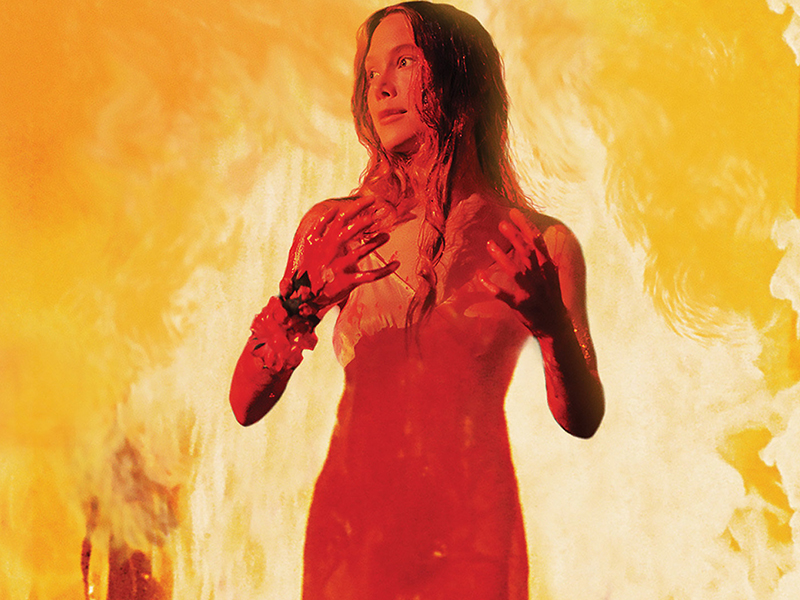
Probably the most famous horror sequence ever is the moment when Carrie (Sissy Spacek), against all odds, steps in the high school gym, on Prom Night, escorted by the most wanted boy in school; the music is idyllic and fantasy-like, the image seems to melt into the most pearly colors in the world; finally, there it is, a common girl, silent and a bit odd, becomes the Prom Queen, people applaud her, what could go wrong? Adapted from Stephen King’s novel of the same name, Carrie offers its protagonist only a glimmer of joy; the popular girls of the school pour a bucket of pig blood on her head just as she receives the crown. In this moment of total agony, the telekinetic girl, extremely repressed by an abusive mother and an awry high school, where she was bullied constantly, lashes out – not only she sets the high school on fire, but it seems that the whole city goes up in flames as she steps lightly, like falling snowflakes, in her velvet dress. It’s a slap in the face directed towards bullying in schools and the hypocrisy of cheerleading culture – all of Carrie’s repressed anger is the invisible struggle that lonely and misfit teenagers carry out every day, without being able to show it in any way.
Journalist and film critic, with a master's degree in film critics. Collaborates with Scena9, Acoperișul de Sticlă, FILM and FILM Menu magazines. For Films in Frame, she brings the monthly top of films and writes the monthly editorial Panorama, published on a Thursday. In her spare time, she retires in the woods where she pictures other possible lives and flying foxes.


